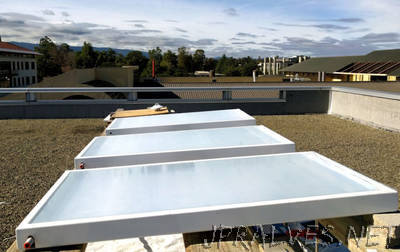
“Stanford scientists cooled water without electricity by sending excess heat where it won’t be noticed – space. The specialized optical surfaces they developed are a major step toward applying this technology to air conditioning and refrigeration.
It looks like a regular roof, but the top of the Packard Electrical Engineering Building at Stanford University has been the setting of many milestones in the development of an innovative cooling technology that could someday be part of our everyday lives. Since 2013, Shanhui Fan, professor of electrical engineering, and his students and research associates have employed this roof as a testbed for a high-tech mirror-like optical surface that could be the future of lower-energy air conditioning and refrigeration.
Research published in 2014 first showed the cooling capabilities of the optical surface on its own. Now, Fan and former research associates Aaswath Raman and Eli Goldstein, have shown that a system involving these surfaces can cool flowing water to a temperature below that of the surrounding air. The entire cooling process is done without electricity.
“This research builds on our previous work with radiative sky cooling but takes it to the next level. It provides for the first time a high-fidelity technology demonstration of how you can use radiative sky cooling to passively cool a fluid and, in doing so, connect it with cooling systems to save electricity,” said Raman, who is co-lead author of the paper detailing this research, published in Nature Energy Sept. 4.
Together, Fan, Goldstein and Raman have founded the company SkyCool Systems, which is working on further testing and commercializing this technology.”
